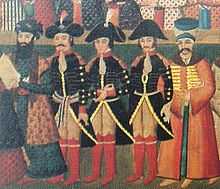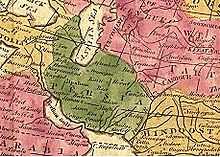Fath-Ali Shah Qajar
| Fat′h-Ali Shah Qajar | |
|---|---|
|
| |
 | |
| Reign | 17 June 1797 – 23 October 1834 |
| Full name | Fat'h Ali Shah |
| Born | 5 September 1772 |
| Birthplace | Damghan, Iran |
| Died | 23 October 1834 (aged 62) |
| Place of death | Isfahan, Iran |
| Buried | Qom |
| Predecessor | Mohammad Khan Qajar |
| Successor | Mohammad Shah Qajar |
| Dynasty | Qajar dynasty |
| Father | Hussein Qoli Khan Qajar |
| Religious beliefs | Shia Islam |
Fat′h Ali Shah Qajar (Persian: فتح على شاه قاجار; var. Fathalishah, Fathali Shah, Fath Ali Shah; 5 September 1772 – 23 October 1834) was the second Qajar Emperor/Shah of Persia. He reigned from 17 June 1797 until his death.
Early life
Fat′h Ali Shah was born in Damghan on 5 September 1772.[1] He was the son of Hossein Qoli Khan Qajar, brother of Agha Mohammad Khan. He was governor of Fars when his uncle was assassinated in 1797. Fath Ali Shah's real name was "Bābā Khān" but he was crowned as Fath Ali Shah. He became suspicious of his chancellor Hajji Ebrahim Khan Kalantar and ordered his execution. Hajji Ebrahim Khan had been chancellor to Zand and Qajar rulers for some fifteen years.[citation needed]
Much of his reign was marked by the resurgence of Persian arts and painting, as well as a deeply elaborate court culture with extremely rigid etiquette. In particular during his reign, portraiture and large-scale oil painting reached a height previously unknown under any other Islamic dynasty, largely due to his personal patronage.
Fat′h Ali also ordered the creation of much royal regalia, including coronations chairs; the "Takht-e Khurshīd" (Persian: تخت خورشید) or Sun Throne; the "Takht-e Nāderi" (Persian: تخت نادری) or Naderi Throne, which was also used by later kings; and the "Tāj-e Kiyāni" (Persian: تاج كيانى) or Kiani Crown, a modification of the crown of the same name created by his uncle Agha Mohammad Khan. The latter, like most of his regalia, was studded with a large number of pearls and gems.
In 1797, Fat′h Ali was given a complete set of the Britannica's 3rd edition, which he read completely; after this feat, he extended his royal title to include "Most Formidable Lord and Master of the Encyclopædia Britannica."[2]
.jpg)
Russo-Persia wars
Russo-Persian War (1804–1813)

During the early reign of Fat′h Ali Shah, Imperial Russia took control of Georgia claimed by the Persians. The war broke between Persia and Russia when Fat′h Ali Shah ordered the invasion of Georgia in 1804, under pressure from the Shia clergy, who were urging a war against Russia. The war began with notable victories for the Persians, but Russia shipped in advanced weaponry and cannons that disadvantaged the technologically inferior Qajar forces, who did not have artillery to match. Russia continued with a major campaign against Persia; Persia asked for help from Britain on the grounds of a military agreement with that country (the military agreement was signed after the rise of Napoleon in France). However, Britain refused to help Persia claiming that the military agreement concerned a French attack not Russian.

Persia had to ask for help from France, sending an ambassador to Napoleon and concluding a Franco-Persian alliance with the signature of the Treaty of Finkenstein. However, just when the French were ready to help Persia, Napoleon made peace with Russia. At this time, John Malcolm arrived in Persia and promised support but Britain later changed its mind and asked Persia to retreat. Russian troops invaded Tabriz in 1813 and Persia was forced to sign the Treaty of Gulistan with Russia.
Treaty of Gulistan
On account of consecutive defeats of Persia and after the fall of Lankaran on 1 January 1813, Shah was forced to sign the Treaty of Gulistan. The text of treaty was prepared by a British diplomat; Sir Gore Ouseley; and was signed by Nikolai Fyodorovich Rtischev from the Russian side"[3] and Hajji Mirza Abol Hasan Khan from the Iranian side on 24 October 1813 in the village of Gulistan.[3]
By this treaty all of the cities, towns, and villages of Georgia, villages and towns on the coast of the Black Sea, all of the cities, towns and villages of the Khanates in South Caucasus and part of the Talysh Khanate, including Megrelia, Abkhazia, Imeretia, Guria, Baku khanate, Shirvan Khanate, Derbent, Karabakh khanate, Ganja khanate, Shaki Khanate and Quba Khanate became part of Russia.[4] In return Russia pledged to support Abbas Mirza as heir to the Persian throne after the death of Fat′h Ali Shah.
Wars with the Afghans
Between 1805 and 1816, Qajar rulers began invading Herat in neighboring Afghanistan. The Persians were attempting to take control of the city but were forced to abandon it due to Afghan uprisings.[5] In 1818 the Shah sent his son Mohammad Vali Mirza to capture the city but was defeated at the Battle of Kafir Qala.
Russo-Persian War (1826–1828)

In 1826, 13 years after the Treaty of Gulistan Shah on the advice of British agents, decided to occupy the lost territories. Abbas Mirza invaded the Talysh Khanate and Karabakh khanate with an army of 35000 on 16 July 1828. In May 1827, Ivan Paskevich, Governor of Caucasus, invaded Echmiadzin, Nakhichevan, Abbasabad and on 1 October Erivan. Fourteen days later, General Eristov entered Tabriz. On January 1828 when Russians reached the shores of Lake Urmia, Abbas Mirza urgently signed the Treaty of Turkmenchay on 2 February 1828.
Treaty of Turkmenchay
Turkmenchay Treaty was signed on 21 February 1828 by Hajji Mirza Abol Hasan Khan and General Ivan Paskievich . By this treaty Erivan khanate, Nakhchivan khanate, Talysh Khanate, Ordubad and Mughan became under the rule of Imperial Russia.[6] Iran pledged to pay Russia 10 Million in Gold and in return Russia pledged to support Abbas Mirza as heir to the Persian throne after the death of Fat′h Ali Shah . The treaty also stipulated the resettlement of Armenians from Persia to the Caucasus, which also included an outright liberation of Armenian captives who were brought and had lived in Iran since 1804 or as far back as 1795.
Later life
Fat′h Ali later employed writers and painters to make a book about his wars with Russia, inspired by the Shahnameh of Ferdowsi. This book, considered by many to be the most important Persian book written in the Qajar period, is called the Shahanshahnama.
In 1829, Alexandr Griboyedov, the Russian diplomat and playwright was killed in the encirclement of the Russia embassy in Tehran. To apologize, the Shah sent Tsar Nicholas I one of the biggest diamonds of his crown Jewelry, Shah Diamond.

When his beloved son and crown prince Abbas Mirza died on 25 October 1833, Fat′h Ali named his grandson Mohammed Mirza as his crown prince. Fat′h Ali died a year later, on 23 October 1834.[1]
He is instantly recognizable in all 25 known portraits – mainly due to his immense, deeply black beard, which reached well beneath his narrow waist. One of these portraits is being exhibited in the collection of the University of Oxford.[7] Another one that of which artist was Mihr Ali is at the Brooklyn Museum.[8]
Besides eulogistic chronicles, the only real sources that allow us to judge his personality are those of British, French and Russian diplomats. These vary greatly: earlier in his reign they tend to portray him as vigorous, manly and highly intelligent. Later they begin to point out his extreme indolence and avarice.[citation needed] Some Victorian sources refer to his baths in the Nigaristan palace which featured a sursura or slide, an inclined marble plane down which "naked harem beauties swooped [...] into the arms of their lord and master before being playfully dunked in a pool."[9][10]

Marriage and children
Fath Ali Shah is reported to have had more than 1,000 spouses.[11] His first son, Mohammad Ali Mirza Dowlatsh, was seven months older than his brother Abbas Mirza (Fat'h Ali Shah's Crown Prince), but on account of his mother, Ziba Chehreh Khanoum,'s non-Qajar origin he was unable to claim the title "Valiahd." (Crown prince).
Sons
- Mohammad Ali Mirza (1788–1821)
- Mohammad Qoli Mirza (1788–1874)
- Mohammad Vali Mirza (1789–1869)
- Abbas Mirza (1789–1833)
- Kiomarth Mirza "Il-Khani"
- Hossein Ali Mirza (1789–1835)
- Hassan Ali Mirza
- Mohammad Taqi Mirza
- Ali Naqi Mirza
- Sheikh Ali Mirza
- Ali Shah Mirza
- Abdollah Mirza
- Imam Verdi Mirza
- Mohammad Reza Mirza
- Mahmud Mirza
- Heydar Qoli Mirza
- Homayoun Mirza
- Allah Verdi Mirza
- Esma'il Mirza
- Ahmad Ali Mirza
- Aliqoli Mirza Etezado-ol-Saltaneh
See also
- Sarah Shahi
- Tangeh Savashi near Tehran, where Fat′h Ali Shah had a relief carved into the side of a mountain pass.
- Imperial Crown Jewels of Persia
- Naderi throne
- Darya-ye Noor Diamond
- Shah Diamond
- Poetry from the inmates of the harem of Fat′h Ali Shah Qajar
References
- ↑ 1.0 1.1 "Index Fa-Fi". Rulers. Retrieved 26 July 2013.
- ↑ William Benton (1968). Banquet at Guildhall in the City of London, Tuesday, 15 October 1968, Celebrating the 200th Anniversary of the Encyclopaedia Britannica and the 25th Anniversary of the Hon. William Benton as Its Chairman and Publisher. Encyclopaedia Britannica. Retrieved 27 July 2013.
- ↑ 3.0 3.1 Treaty of Gulistan
- ↑ John F. Baddeley, "The Russian Conquest of the Caucasus", Longman, Green and Co., London: 1908, p. 90
- ↑ Dumper, Michael; Bruce E. Stanley (2007). Cities of the Middle East and North Africa: A Historical Encyclopedia. ABC-CLIO. p. 170. ISBN 1-5760-7919-8. Retrieved 2010-08-22.
- ↑ Treaty of Turkmenchay
- ↑ "Your Paintings". BBC. Retrieved 26 July 2013.
- ↑ "Portrait of Fath 'Ali Shah Qajar". Brooklyn Museum. Retrieved 26 July 2013.
- ↑ John H. Waller, Beyond the Khyber Pass: the road to British disaster in the First Afghan War, Random House, 1990, p. 59.
- ↑ The Literary World. 1882. p. 85. Retrieved 1 December 2012. Wording also available here under "The Shah's Palaces"
- ↑ "Qajar King Paraded Top-Cadre Wives Every Morning: Iraniain Historian Says". Payvand. 13 August 2004. Retrieved 26 July 2013.
External links
- Portrait of Fat′h Ali Shah by Mihr Ali, Qajar Pages
- Complete list of Fath Ali Shah's Descendants, Manoutchehr M. Eskandari-Qajar (Kadjar), Qajar Pages
- Fath Ali Shah's Standing Portrait by Mihr Ali, 1809–1810, Hermitage Museum, Hermitage Museum
- Seated Portrait of Fath Ali Shah, by Mihr Ali, 1813–1814, presented by the Shah in 1817 to Aleksey Petrovich Yermolov, Hermitage Museum, Hermitage Museum
| Wikimedia Commons has media related to Fat′h Ali Shah Qajar. |
- Genealogy of Fath Ali (Royalark.net)
- Fath 'Ali Shah seated on the Peacock Throne, miniature from Shāhanshāhnāmeh of sābā British Library
- Divān-i-Khāqān, Fat′h Ali Shah's own Poems, presented by the Shah to the Prince Regent in 1812, now in Royal Library at Windsor Castle, royal collection
- Louvre
- Crown
- Photos of qajar kings
| Fath-Ali Shah Qajar Qajar Dynasty Born: 5 September 1772 Died: 23 October 1834 | ||
| Regnal titles | ||
|---|---|---|
| Preceded by Agha Mohammad Khan Qajar |
Shah of Persia 1797–1834 |
Succeeded by Mohammad Shah Qajar |
| |||||